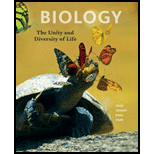
Organic molecules consist mainly of ______ atoms.
- a. carbon
- b. carbon and oxygen
- c. carbon and hydrogen
- d. carbon and nitrogen
Introduction: The molecules that are majorly composed of carbon and hydrogen are classified by chemists as organic molecules. The basis of life is the organic compounds that make it up. Organic chemistry is the study of these compounds. The methodology of synthesis of these compounds is called as organic synthesis.
Answer to Problem 1SQ
Correct answer: The organic compounds are those that consist majorly of carbon and hydrogen atoms. Hence, the correct answer is option c.
Explanation of Solution
Reason for correct answer:
The living organisms are composed of several molecules. They are called as molecules of life. The molecules of life include carbohydrates, fats, proteins, nucleic acids, and many more. They are made of organic molecules, which mainly consist majorly of carbon and hydrogen atoms. The organic molecules also have oxygen, nitrogen, sulphur, and phosphorus atoms in a minor form. These organic molecules are also found in the non-living things.
Option c. is given as “carbon and hydrogen”.
The organic compounds consist mainly of both carbon and hydrogen atoms that are present in different proportions to form various functional groups.
Hence the correct answer is option c.
Reason for incorrect answer:
Option a. is given as “carbon”.
Though the carbon atoms majorly constitute the organic compounds, chemists define organic compounds as those with both carbon and hydrogen atoms. Hence, option a. is incorrect.
Option b. is given as “carbon and oxygen”.
Certain organic molecules like carboxylic acids, carbonyl functions groups, aldehyde groups, and ketone groups contain both carbon and oxygen atoms; oxygen is present in lesser amount than hydrogen. Hence, option b. is incorrect.
Option d. is given as “carbon and nitrogen”.
Certain organic molecules like amino acids, nucleic acids, phospholipids, amides, amines, nitrile, and imine functional groups. Hence, option d. is incorrect.
Hence the options a., b., and d are incorrect.
Want to see more full solutions like this?
Chapter 3 Solutions
Biology: The Unity and Diversity of Life (MindTap Course List)
Additional Science Textbook Solutions
Anatomy & Physiology (6th Edition)
Campbell Biology (10th Edition)
Study Guide for Campbell Biology
Biological Science (6th Edition)
Concepts of Biology
Biology: Life on Earth (11th Edition)
- Miller and Urey created a reaction chamber that simulated conditions in Earths early atmosphere to test the hypothesis that______. a. lightning-fueled atmospheric reactions could have produced organic compounds b. meteorites contain organic compounds c. organic compounds form at hydrothermal vents d. oxygen prevents formation of organic compoundsarrow_forwardWhich of the following statements is incorrect? a. Isotopes have the same atomic number and different mass numbers. b. Atoms have about the same number of electrons as protons. c. All molecules consist of atoms. d. Free radicals are dangerous because they emit energyarrow_forwardWhich of the following alters proteins and membranes? a. Alcohols b. Iodine c. All other choices d. Phenolic compoundsarrow_forward
- Fats do not dissolve in water because Select one: a. There are no C-H bonds to form hydrogen bonds with water b. There are no O-H bonds form hydrogen bonds with water c. There are no C-C bonds to form hydrogen bonds with water d. There are no C-H bonds for covalent bonds with water e. There are no C-C bonds to form covalent bonds with waterarrow_forwardEnzymes are organic catalysts that (a) alter the direction in which a chemical reaction proceeds, (b) determine the nature of the products of a reaction, (c) increase the speed of a chemical reaction, (d) are essential raw materials for a chemical reaction that are converted into some of its products.arrow_forwardAll carbohydrates are made up of what atoms?* Please choose one correct answer only. A. Carbon, hydrogen, nitrogen B. Carbon, nitrogen, oxygen C. Carbon, hydrogen, oxygen D. Carbon, hydrogen, sulfurarrow_forward
- The carbon-to-nitrogen bond that joins amino acids together is called a.a glycosidic bond. b.a peptide bond. c.a hydrogen bond. d.a double bond.arrow_forward_________________ are the building blocks of proteins. a. Nucleic Acids b. Amino Acids c. Hydrochloric Acids d. Ribonucleic Acidsarrow_forwardWhich one is NOT TRUE for ice floating on water? a. The density of ice is less than water. b. Hydrogen bonds are ordered. c. It has less stable hydrogen bonds. d. Life is impossible below ice in Antarctica.arrow_forward
- Compare nucleic acids with polysaccharides. Which of the following is NOT true? Group of answer choices A) Both have monomers that contain simple sugars. B) Both function as structural support for cells. C) Both types of molecules are organic. D) Both are polymerized by dehydration reactions. .arrow_forwardOrganic molecules consist mainly of _______ atoms. a. carbon c. carbon and hydrogen b. carbon and oxygen d. carbon and nitrogenarrow_forwardWhich of the following statements is not true? a. Water is polar. b. Water stabilizes temperature. c. Water is essential for life. d. Water is the most abundant atom in Earth’s atmosphere.arrow_forward

 Biology (MindTap Course List)BiologyISBN:9781337392938Author:Eldra Solomon, Charles Martin, Diana W. Martin, Linda R. BergPublisher:Cengage Learning
Biology (MindTap Course List)BiologyISBN:9781337392938Author:Eldra Solomon, Charles Martin, Diana W. Martin, Linda R. BergPublisher:Cengage Learning Concepts of BiologyBiologyISBN:9781938168116Author:Samantha Fowler, Rebecca Roush, James WisePublisher:OpenStax College
Concepts of BiologyBiologyISBN:9781938168116Author:Samantha Fowler, Rebecca Roush, James WisePublisher:OpenStax College Human Biology (MindTap Course List)BiologyISBN:9781305112100Author:Cecie Starr, Beverly McMillanPublisher:Cengage Learning
Human Biology (MindTap Course List)BiologyISBN:9781305112100Author:Cecie Starr, Beverly McMillanPublisher:Cengage Learning



